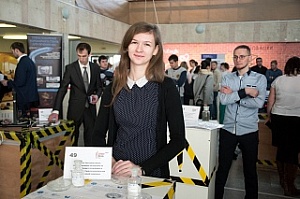A highlight of Science Week at TSU was the exhibition Youth and Industry, in which young Tomsk scientists presented their developments. The exhibition had included seven developments by TSU researchers.
Visitors viewed interesting research projects and teams, took part in the popular science shows and workshops, and watched the dancing robots. During the event, visitors were choosing the best photo of a scientific project and could win prizes in the competition of selfies with exhibits.
- Demonstrating your results and communicating are the best ways to know your colleagues and understand where we are going, - Mikhail Sonkin, Deputy Governor for the Scientific and Educational Complex, said at the opening ceremony.
Among the projects presented by TSU scientists were a hardware-software complex for diagnostics of the marine environment, with which you can evaluate biological resources and forecast the effects of human activities. With the complex, water diagnosis can be made directly on the open sea.
- We can talk about the state of the marine environment focusing on the state of the plankton. If some species are fewer, it may indicate the contamination of the water, - said Alexander Davydov, a junior research assistant at the Laboratory for Radiophysical and Optical Methods of Exploring the Environment.
TSU scientists also presented a two-step production technology of xanthan, the development of a method for the synthesis of glycolic acid, and a catalyst by which the effectiveness of Russian oil processing facilities can be increased.
- Our development has no analogs in Russia, there are only two of these in the world, - said Gregori Mamontov, a senior research assistant at the Laboratory of Catalytic Research. - At the moment we are looking for an industrial partner who would be interested in the production of the catalyst for the Russian and international markets.
The exhibition also presented biocompatible composite materials to replace and restore bone tissue. TSU scientists demonstrated a method for obtaining nanoparticles using impulse laser ablation and, in conjunction with researchers from the Institute of Strength Physics and Materials (Siberian Branch of the Russian Academy of Sciences), implants offrom bioactive ceramics.

